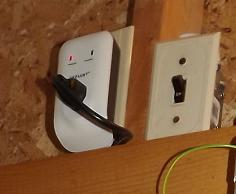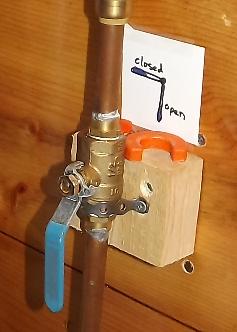

UV water purification systems are fairly easy to install. Ours is a Rainfresh model that can process up to 8 US gallons per minute. The photo on the right shows the whole installed system. Because our water may have some rust in it, we pass the water through a Rainfresh whole house filter to ensure that the water is clear enough for the UV system to disinfect it.
Note the use of SharkBite fittings with the three-quarter-inch copper pipes. When you assemble your system with these, it makes it very easy to disassemble if any problems occur.
The system consists of the following components:
Whole House Pre-filter |
 |
We are using a Rainfresh whole-house filter to remove any particulate matter such as rust or fine sand. It uses cartridges that need replacing periodically when they get gummed up. Various types of cartridges are available with different filtering capabilities. The one you choose will depend on the size of the particulate matter that you want to filter out. The filter unit sits between the water tank and the UV unit. This particular one has a tap on top (square and blue) that can turn the water off completely or bypass the actual filter. This is useful when you want to change the filter cartridge or the UV lamp. |
UV Filter Unit |
 |
The unit consists of a metal casing that contains a "dome" (really a tube with the bottom end closed) within which an ultra-violet flourescent tube (or lamp) is situated. Water feeds in from the bottom of the unit and is purified by the UV light as it rises to the top. Because UV light can cause plastic to deteriorate, the fittings and pipes connecting to the unit should not be plastic, as the light will refract through the pipes and can damage them. The manufacturers recommend that there should be a 12-inch stretch of copper pipe on the inlet and outlet of the unit before any plastic fittings are used. The UV lamps have a limited life and it is recommended that they be replaced each year. They actually have a life of around 9,000 hours of use, which is approximately a year. However, this assumes that the lamp will be switched on for the whole year. In a cottage that is not used for much of the year, a lamp should last a lot longer. We turn off the unit each time we leave the cottage and go home. A new lamp costs around $100. In the fall, when you empty your water system, it's a good idea to remove the UV lamp and the dome from the unit. If you happen to have any water in the system still and it freezes, it can break the dome and ruin the UV lamp. Getting broken pieces of the dome out of the unit's three openings is extremely difficult and frustrating. Taking the dome out also gives you the opportunity to clean it to maintain efficiency. |
Control Unit |
 |
The control unit is a transformer and ballast that provides power to the UV lamp, and also keeps track of the number of hours the lamp has been used. It will provide a warning when the lamp is nearing the end of its life and needs to be replaced. |
Surge Protector |
 |
The surge protector helps to protect the control unit and lamp in case the power surges on the main electrical supply. This can happen during thunder storms, and can destroy the control unit. The surge protector shown costs about $15, which is a reasonable outlay to protect a control unit that can cost around $200 to replace. The efficacy of surge protectors is measured in joules, and you should get one that that has a joule rating of at least 1000. |
Water Shut-off Tap |
 |
This tap closes off the flow of water to the house, which is useful when you need to work on plumbing somewhere in the system, and it saves you from the necessity of draining the UV system. |
Drain Tap |
 |
The drain tap allows you to drain the water out of the UV system in order to change the UV lamp. It is also necessary to drain it in winter if your cottage is not winterized. |